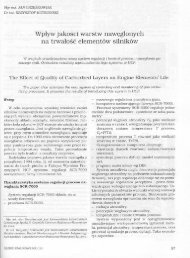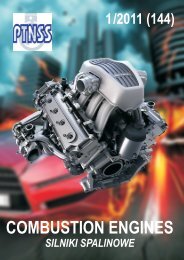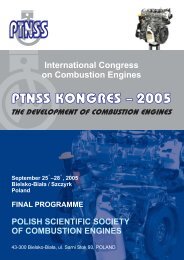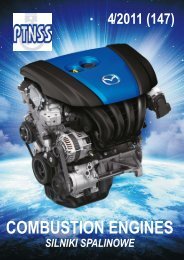You also want an ePaper? Increase the reach of your titles
YUMPU automatically turns print PDFs into web optimized ePapers that Google loves.
Źródła zanieczyszczeń i uszkodzeń części przepływowej okrętowego turbinowego...<br />
suming that in each consecutive stage of the compressor<br />
the temperature of the working medium rises by 15 ÷ 20<br />
K it turns out that the greatest sedimentation rate of the<br />
mineral salts is already on the first 4 ÷ 5 stages, where<br />
the temperature of the sucked pyrosol reaches 350 ÷ 380<br />
K. In an engine operating at a given, steady load range,<br />
the contamination of the flow part in the form of deposits<br />
is limited to the initial stages of the compressor. As the<br />
endoscopic examinations show, frequent changes in the<br />
engine load facilitate the growth of the evenness of the<br />
distribution of the deposits on the intervane channels of<br />
the compressor part [7].<br />
The mineral salts<br />
transported in the intake<br />
air deposit on the<br />
elements of the flow<br />
part and are bonded<br />
with the surface<br />
through oil vapors<br />
from the labyrinth<br />
seals and the products<br />
of combustion<br />
sucked in with the intake<br />
air. The soot and<br />
oil vapors, carried by<br />
the pyrosol, deposit<br />
mainly on the guide<br />
vanes and the first<br />
2 ÷ 3 stages of the compressor.<br />
The thickness<br />
of the deposit layer in<br />
the compressor part<br />
may reach values of<br />
tenths of millimeter<br />
and the greatest concentration<br />
occurs on<br />
the guide vanes up to the 2/3 of their height counting from<br />
the top – Fig. 3.<br />
The layer of the deposit is composed of the salts of sodium,<br />
magnesium, calcium, potassium, carbon compounds<br />
and ferric oxides. A part of these components, getting<br />
through to the combustor and farther, forms, together with<br />
the products of combustion, a layer of a difficult-to-remove<br />
deposit on the flow channels of the turbines. The nature and<br />
chemical composition of the deposit mainly depends on the<br />
physical and chemical properties of the used fuel, the quality<br />
of the combustion process, the efficiency of pyrosol filtering<br />
at the intake and the frequency of the cleaning procedure of<br />
the flow part. Also, the way of cooling of the vanes plays<br />
and important role in the mechanism of deposit formation<br />
inside the turbines.<br />
The conducted endoscopic examinations have shown a<br />
much greater intensity of the contamination of vanes cooled<br />
with air fed from the compressor part of the engine. The<br />
difference of the particle concentration near the surface<br />
of the vane and in the region of the cooling air outlet is<br />
a consequence of an uneven field of temperature and the<br />
silników okrętowych nawet do 100 kg/s, co oznacza, że wraz<br />
z zasysanym powietrzem przedostają się również znaczne<br />
ilości soli wody morskiej. Dla rejonu Morza Bałtyckiego,<br />
gdzie zasolenie wody jest niewielkie i wynosi średnio 7,2<br />
g/kg, a w warstwie przywodnej stężenie (zawartość) soli<br />
w powietrzu wynosi 0,1 mg/kg, tylko podczas jednej godziny<br />
pracy silnika na nominalnym zakresie obciążenia do<br />
części przepływowej przedostaje się około 0,03 ÷ 0,05 kg<br />
soli [5].<br />
Część soli tylko przepływa przez silnik, część natomiast<br />
pozostaje, zanieczyszczając jego kanały przepływowe.<br />
Mechanizm powstawania zanieczyszczeń jest następujący.<br />
Fig. 2. The classification of the possible sources of contamination in the air feeding the marine turbine engine<br />
Rys. 2. Klasyfikacja możliwych źródeł zanieczyszczeń powietrza zasilającego okrętowy turbinowy silnik spalinowy<br />
Kropelki wody morskiej, zawierające w sobie rozpuszczone<br />
cząsteczki soli, przedostają się w głąb sprężarki, intensywnie<br />
odparowując. Przy założeniu, że w każdym kolejnym stopniu<br />
sprężarki temperatura czynnika roboczego podnosi się o<br />
15 ÷ 20 K okazuje się, że największa intensywność osadzania<br />
się soli mineralnych występuje już na pierwszych 4 ÷ 5<br />
stopniach, gdzie temperatury zasysanego pyrozolu osiągają<br />
350 ÷ 380 K. W silniku pracującym w zadanym, ustalonym<br />
zakresie obciążenia zanieczyszczenie części przepływowej<br />
w postaci osadów soli ogranicza się do początkowych stopni<br />
sprężarki. Jak wykazują wyniki badań endoskopowych,<br />
częste zmiany obciążenia silnika sprzyjają zwiększeniu<br />
równomierności rozkładu osadu zanieczyszczeń wzdłuż<br />
kanałów międzyłopatkowych części sprężarkowej [7].<br />
Sole mineralne transportowane w powietrzu dolotowym<br />
do silnika osadzają się na elementach części przepływowej<br />
i wiązane są z podłożem parami oleju z uszczelnień labiryntowych<br />
oraz produktami spalania zasysanymi do silnika<br />
wraz z powietrzem. Sadza i opary olejowe, które niesie<br />
zasysany przez silnik pyrozol osadzają się głównie na kierownicy<br />
wlotowej i pierwszych 2 ÷ 3 stopniach sprężarki.<br />
12 <strong>COMBUSTION</strong> <strong>ENGINES</strong>, No. 4/2012 (151)












